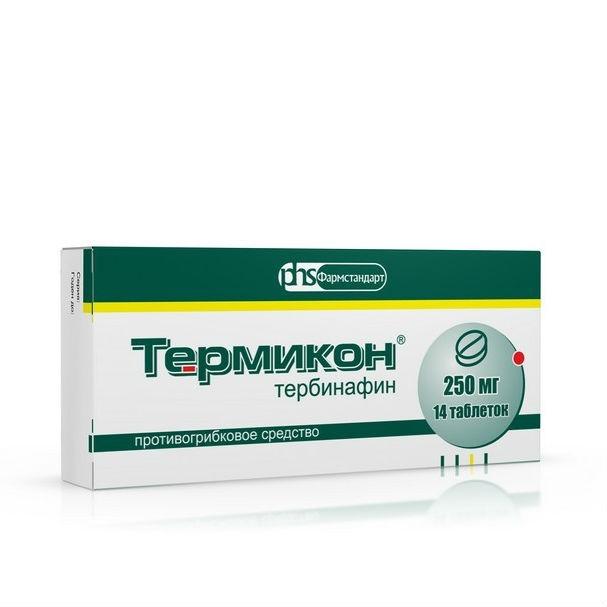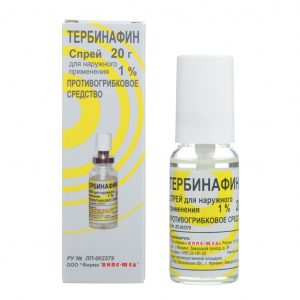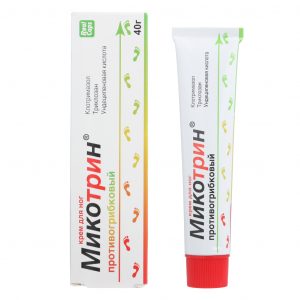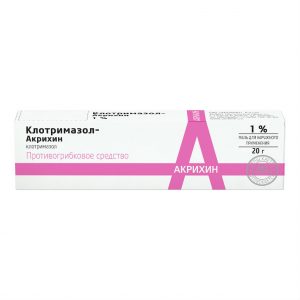Description
release form
tablets
Packing
14 pcs
Pharmacological action
Thermicon is an antifungal drug, allylamine. It has a wide range of antifungal effects.
Active against dermatophytes: Trichophyton rubrum, Trichophyton mentagrophytes, Trichophyton tonsurans, Trichophyton verrucosum, Trichophyton violaceum, Microsporum canis, Epidermophyton floccosum. At low concentrations, it has a fungicidal effect on dermatophytes, mold fungi (including Aspergillus, Cladosporium, Scopulariopsis brevicaulis) and some dimorphic fungi. On yeast fungi of the genus Candida (mainly Candida albicans) and their mycelial forms, depending on the species, the drug has a fungicidal or fungistatic effect.
Thermicon disrupts the early stage of biosynthesis of the main component of the cell membrane of the ergosterol fungus by inhibiting the squalene epoxidase enzyme. This leads to a deficiency of ergosterol and to intracellular accumulation of squalene, which causes the death of the fungal cell. The action of terbinafine is carried out by inhibiting the enzyme squalene epoxidase located on the cell membrane of the fungus.
Pharmacokinetics
Absorption
After oral administration, the drug is well absorbed from the digestive tract. After 0.8 h, half of the dose taken is absorbed.
After a single dose of 250 mg of Cmax terbinafine in plasma is achieved after 1-2 hours and is 0.97 mcg / ml. Bioavailability is 80%. Eating does not affect the bioavailability of terbinafine.
Distribution of
Plasma Protein Binding – 99%.
4.6 hours after ingestion, half the dose taken is distributed in the body. The drug quickly penetrates the dermal layer of the skin and nail plates. It penetrates the secret of the sebaceous glands, accumulates in high concentrations in the hair follicles, hair, skin and subcutaneous tissue. Does not cumulate in the body.
Terbinafine is excreted in breast milk.
Metabolism
Biotransformed in the liver to form inactive metabolites.
Excretion of
About 80% of the accepted dose is excreted in the form of metabolites in the urine, the rest with feces (22%).
Pharmacokinetics in special clinical cases
Patient age does not affect the pharmacokinetics of terbinafine, however, drug excretion may decrease with kidney or liver damage, leading to high concentrations of terbinafine in the blood.
T1 / 2 is 16-18 hours. T1 / 2 in the terminal phase is 200-400 hours.
Indications of
mycosis of the scalp (trichophytosis, microsporia)
mycoses of the skin and nails due to Trichophyton rubrum, Trichophyton mentagrophytes, Trichophyton tonsurans, Trichophyton verrucosum microsporumfomycrymphis canis the skin of the trunk and limbs, requiring systemic treatment of
candidiasis of the skin and mucous membranes.
Contraindications
pregnancy
breastfeeding period
children under 3 years of age and children weighing up to 20 kg
hypersensitivity to the components of the drug.
With caution, the drug should be used orally for renal and / or liver failure, alcoholism, inhibition of bone marrow hematopoiesis, tumors, metabolic diseases, and occlusive diseases of the limb vessels.
Use during pregnancy and lactation
Taking terbinafine during pregnancy is contraindicated due to the lack of sufficient data on its safety during pregnancy.
Terbinafine is excreted in breast milk, therefore, his appointment is contraindicated in the period of breastfeeding.
Composition
1 tablet contains:
Active ingredient: t
erbinafine 250 mg
Excipients:
sodium starch glycolate,
hydroxypropyl methylcellulose,
microcrystalline cellulose,
milk sugar,
aerosil,
magnesium stearate.
Dosage and administration
The duration of the course of treatment and the dosage regimen is set individually and depends on the localization of the process and the severity of the disease.
Inside adults, the drug is prescribed 250 mg 1 time per day (after eating).
With onychomycosis, the duration of treatment is about 6-12 weeks. With onychomycosis of the hands and feet (with the exception of the big toe), or in young patients, the duration of treatment may be less than 12 weeks. With a big toe infection, a treatment course of 3 months is usually sufficient. In rare cases, with a slowed nail growth rate, longer treatment may be required – up to 6 months or more.
With dermatomycosis of the feet (interdigital, plantar or by type of socks) the duration of treatment is from 2 to 6 weeks with dermatomycosis of the legs – from 2 to 4 weeks with dermatomycosis of the trunk – 4 weeks with candidiasis of the skin and mucous membranes from 2 to 4 weeks.
For scalp mycosis caused by Microsporum canis, the recommended treatment duration is more than 4 weeks.
For children with a body weight of 20 to 40 kg, the drug is prescribed at a dose of 125 mg (1/2 tab.) 1 time per day, with a body weight of more than 40 mg – 250 mg 1 time per day. The duration of treatment for mycosis of the scalp is about 4 weeks. In cases where the causative agent is Microsporum canis, treatment may be longer.
In elderly patients, the drug is prescribed in the same doses as adults.
In severe renal failure (KK300 µmol / l), in case of impaired renal function, the dose should be reduced by 2 times, for adults – 125 mg 1 time per day.
Side effects
From the digestive system: dyspepsia, decreased appetite, nausea, diarrhea, a feeling of fullness of the stomach, abdominal pain, impaired taste sensations, including their loss (recovery occurs within a few weeks after stopping treatment) very rarely – hepatobiliary disorders (cholestatic jaundice).
From the musculoskeletal system: arthralgia, myalgia.
From the hemopoietic system: agranulocytosis, thrombocytopenia, neutropenia.
Allergic reactions: urticaria, rash very rarely – toxic epidermal necrolysis (Lyell’s syndrome), anaphylactoid reactions, malignant exudative erythema (Stevens-Johnson syndrome).
drug interaction
terbinafine inhibits the CYP2D6 isoenzyme and slows the metabolism of drugs such as tricyclic antidepressants and selective serotonin reuptake inhibitors (eg, desipramine, fluvoxren), beta1, adopors, beta type B (e.g. selegiline) and antipsychotic drugs (eg, chlorpromazine, haloperidol).
Cytochrome P450 isoenzyme inducers (eg rifampicin) can accelerate the elimination of terbinafine from the body, cytochrome P450 isoenzyme inhibitors (eg cimetidine) can slow it down. When used with such drugs, dose adjustment of tebinafine may be required.
When taking terbinafine and oral contraceptives, menstrual irregularities may occur.
Terbinafine reduces caffeine clearance by 20% and increases its T1 / 2 by 31%.
Terbinafine does not affect the clearance of antipyrine, digoxin, warfarin.
Ethanol and other hepatotoxic drugs, when used with Termicon, increase the risk of hepatotoxicity.
Overdose
Symptoms: nausea, vomiting, pain in the lower abdomen and epigastric region, dizziness.
Treatment: gastric lavage followed by activated charcoal and / or symptomatic therapy.
Storage conditions
Store at a temperature not exceeding 25 ° C, out of the reach of children.
Expiration
2 years.
Deystvuyuschee substances
Terbinafine
Pharmacy terms of sale
Prescription
Dosage form
dosage form
tablets
Pharmstandard-Leksredstva, Russia




